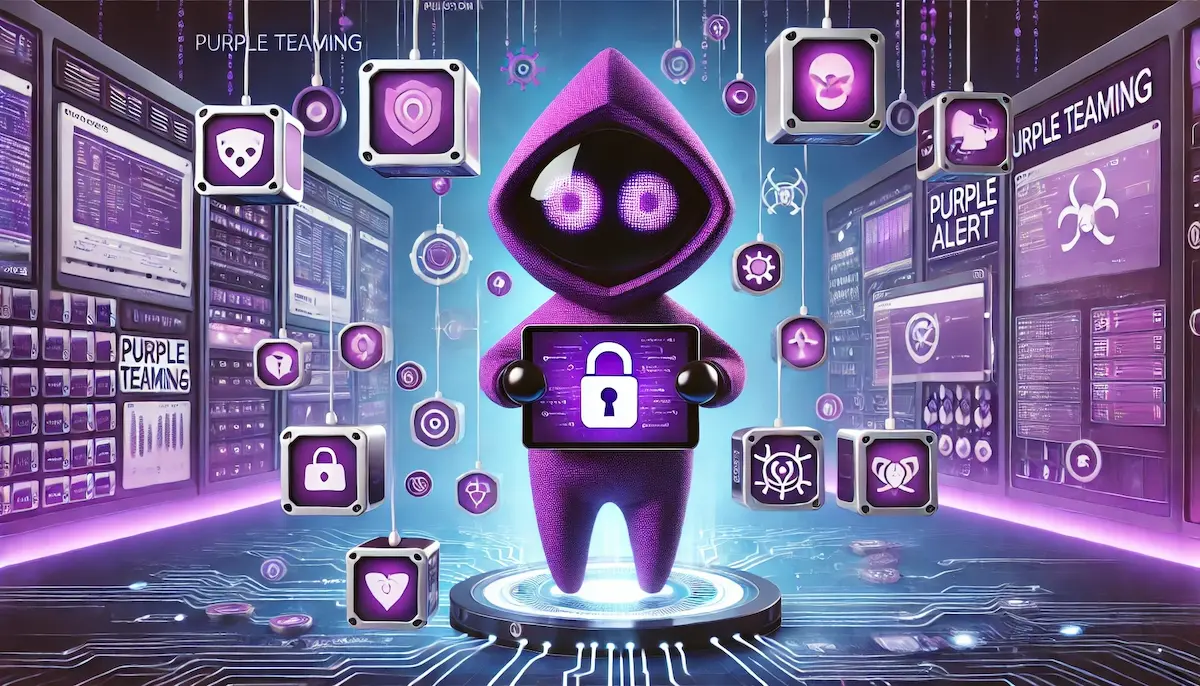Purple Teaming is a collaborative cybersecurity approach that integrates the efforts of both Red Teams (offensive security) and Blue Teams (defensive security) to enhance an organization’s overall security posture. By fostering communication and cooperation between these traditionally separate teams, Purple Teaming aims to improve threat detection, response capabilities, and the implementation of effective security measures.
What is Purple Teaming?
Purple Teaming involves a continuous feedback loop between Red and Blue Teams. The Red Team simulates attacks and attempts to breach the organization’s defenses, while the Blue Team monitors, detects, and responds to these simulated attacks. The insights gained from these exercises are shared and used to strengthen security defenses and refine offensive tactics. This collaborative approach helps organizations identify and address vulnerabilities more effectively.
Key Components of Purple Teaming
Purple Teaming encompasses several critical components that ensure a comprehensive and integrated approach to cybersecurity:
- Collaboration: Encourages constant communication and cooperation between Red and Blue Teams to share findings and strategies.
- Simulated Attacks: Red Teams conduct realistic attack simulations to test the organization’s defenses.
- Real-Time Feedback: Blue Teams provide immediate feedback on detection and response capabilities during and after simulations.
- Continuous Improvement: Both teams work together to refine tactics, techniques, and procedures, improving overall security measures.
- Training and Education: Enhances the skills and knowledge of both teams through joint exercises and knowledge sharing.
Benefits of Purple Teaming
Implementing a Purple Teaming strategy offers several significant benefits for organizations:
- Enhanced Threat Detection: Improves the Blue Team’s ability to detect and respond to sophisticated threats by leveraging insights from the Red Team.
- Proactive Defense: Identifies and addresses vulnerabilities before they can be exploited by real attackers.
- Comprehensive Security: Combines offensive and defensive perspectives to create a more robust and well-rounded security strategy.
- Improved Communication: Fosters better communication and collaboration between different security teams, leading to more effective incident response.
- Cost Efficiency: Maximizes the value of security investments by ensuring that both offensive and defensive measures are continuously tested and improved.
Purple Teaming vs. Red and Blue Teaming
While Red and Blue Teaming focus on offensive and defensive activities respectively, Purple Teaming integrates these efforts for a more holistic approach:
- Red Teaming: Focuses on simulating attacks to identify vulnerabilities and test the effectiveness of security measures.
- Blue Teaming: Concentrates on protecting the organization by monitoring, detecting, and responding to security threats.
- Purple Teaming: Combines both approaches, facilitating collaboration between Red and Blue Teams to continuously improve security defenses and response capabilities.
Implementing Purple Teaming
Implementing a successful Purple Teaming strategy involves several steps:
- Assessment: Evaluate the current security posture and identify areas where collaboration between Red and Blue Teams can be improved.
- Define Objectives: Set clear goals for the Purple Teaming exercises, focusing on improving detection, response, and overall security.
- Build the Team: Assemble skilled Red and Blue Team members who are open to collaboration and knowledge sharing.
- Plan and Execute Simulations: Conduct realistic attack simulations and ensure that both teams work together to analyze and respond to these simulations.
- Analyze and Share Insights: Review the outcomes of the simulations, identify strengths and weaknesses, and share insights between teams.
- Implement Improvements: Use the findings to enhance security measures, refine tactics, and update policies and procedures.
- Continuous Learning: Regularly conduct Purple Teaming exercises to keep up with evolving threats and continuously improve the organization’s security posture.
The Future of Purple Teaming
As cyber threats become more sophisticated, the practice of Purple Teaming is expected to evolve with several key trends:
- Advanced Automation: Leveraging AI and machine learning to automate attack simulations, threat detection, and response actions, enhancing the efficiency of Purple Teaming exercises.
- Integrated Security Platforms: Utilizing comprehensive security platforms that facilitate seamless collaboration between Red and Blue Teams.
- Focus on Threat Intelligence: Enhancing Purple Teaming efforts with real-time threat intelligence to stay ahead of emerging threats.
- Adaptive Security Strategies: Developing flexible and adaptive security strategies that can quickly respond to new and evolving attack vectors.
- Cross-Functional Collaboration: Expanding Purple Teaming beyond cybersecurity teams to include other departments such as IT, risk management, and compliance for a more holistic approach to organizational security.
Blockfine thanks you for reading and hopes you found this article helpful.
